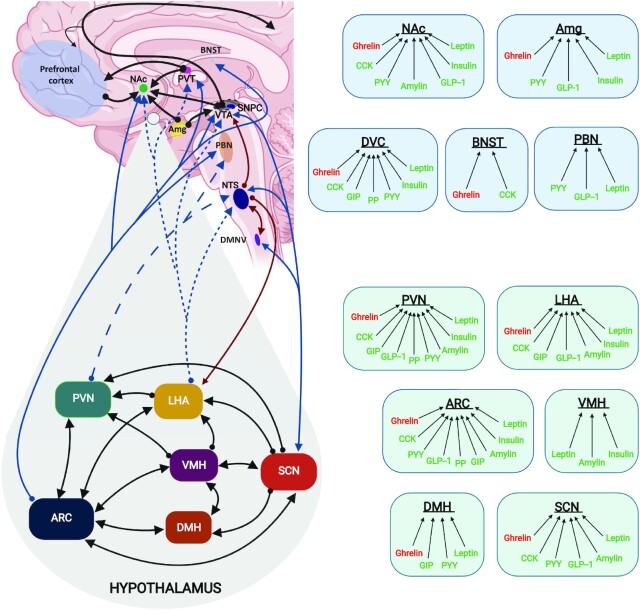FIGURE 1.
An integrated overview of the brain regions and peripheral hormones involved in hunger and satiety. Right box panels depict the interaction of peripheral gut hormones with specific brain regions. Several hunger (ghrelin and orexin) and satiety (leptin, insulin, GLP-1, amylin, PYY, CCK, GIP) peptide hormones cross the blood–brain barrier and elicit responses in the regions alluded via unique receptor activation. Left panel: Black arrows in the non-hypothalamic region indicate neural projection connections in the mesocorticolimbic system (which includes the VTA/SNPC, Amg, NAc, PVT, and prefrontal cortex), dark-red arrows depict the DVC, made up of DMNC and NTS, in the hypothalamus: the blue dotted line indicates connections between the LHA and extrahypothalamic areas, the blue dashed line indicates the connections from the PVN to extrahypothalamic areas; black lines indicate intrahypothalamic connections between nuclei; bidirectional arrows suggest neural projections going both directions. Created with Biorender.com, Toronto, Ontario. Amg, amygdala; ARC, arcuate nucleus; BNST, bed nuclei of stria terminalis; CCK, cholecystokinin; DaMH, dorsal medial hypothalamus; DMNV, dorsal motor nucleus of the vagus; DVC, dorsal vagal complex; GIP, gastrointestinal peptide; GLP-1, glucagon-like-peptide 1; LHA, lateral hypothalamus; NAc, nucleus accumbens; NTS, nucleus tractus solitarius; PBN, parabrachial nucleus; PP, pancreatic polypeptide; PVN, paraventricular nucleus; PVT, paraventricular thalamus; PYY, peptide YY; SCN, suprachiasmatic nucleus; VMH, ventral medial hypothalamus; VTA/SNPC, ventral tegmental area/substantia nigra pars compacta.

